Bamboo and lacquer masterworks by
Ikeda Iwao


Bamboo and lacquer masterworks by
Ikeda Iwao

Illustrated as cover and on page 39
3 ( Estrangement of Awareness 3 ), 2018
Bamboo, lacquer and gold
Height: 44.0cm
ISBN: 978 1 873609 56 9
Design, Typesetting and Photography Daniel M. Eskenazi
Printed and originated by Graphicom Srl., Vicenza © copyright 2025 ESKENAZI London
Bamboo and lacquer masterworks by Ikeda Iwao
12 May - 4 July 2025
10 Clifford Street London W1S 2LJ
Telephone: 020 7493 5464
e-mail: gallery@eskenazi.co.uk
web: www.eskenazi.co.uk
序文
このたび、池田巌氏の展覧会を開催 させていただけますことを大変光栄に 思いま す。私の父が、東京での展覧会で初めて 池田氏と出会 ってから30年余りが経ちま した 。二人 はともに骨董を深く愛し 、お 互いの業績 に 尊敬 の念を抱くだけでなく、 生まれた日もたった 数カ月 違いというご縁があります 。
池田氏は、これまでニューヨークのメトロポリタン美術館やベルリン国立美術館 をはじめ、世界各地で数多くの 重要な 展覧会を開 かれ ました 。しかし、今回初めて ロンドンで 個展が開催される運びとなり、とても 嬉しく思っております。
池田氏は竹と漆 の技法を学ぶための本格的な修行を積まれた後 、その卓越した わざを活かして 、竹と漆という素材そのものの本質を引き出すような 独自の芸術 表現へと昇華させました。竹は 世界中で広く親しまれる植物で、その強靭さ、しな やかさ、そして真っ直ぐと伸びる 姿はよく知られています 。しかし池田氏は 、竹 に 漆を塗り、裂 き、削ることで、その内なる 気 を探求し、表現 されているのです 。
本展覧会は決して池田氏の作品を網羅するものではありませんが、これまで の創 作活動で追求してこられた 主要なテーマの一端を紹介しています 。立体 作品とい うものは 、実際に目にすることで生き生きと輝きだします 。展示期間中の夏の間 に、ぜひ多くの方々にギャラリーへ足を運んでいただき、作品を直接ご覧いただけ ればと思います。
最後に、池田氏がこれらの素晴らしい作品を私たちに託してくださったことに感 謝申し上げます。また、本カタログに洞察に満ちたエッセイを寄せてくださった工 芸史家であり、元 東京国立近代美術館主任 研究員 で いらっしゃる諸山正則 氏に も深く感謝いたします。さらに、関係者間の円滑なコミュニケーションを支えてく ださった大口雅美氏、すべての翻訳を担当してくださったドゥオン 彩子氏にも、心 よりお礼申し上げます。そして、当カタログのすべての文章が正確で適切なものと なるよう尽力してくださったサラ・ウォン氏にも、感謝の意を表します。
ダニエル・エスケナ ジ
Foreword
We are proud to present an exhibition by the celebrated artist Ikeda Iwao who my father met some thirty years ago at an exhibition in Tokyo. Not only do they share a love of art and antiques and have mutual respect for each other’s achievements but were also born only a few months apart.
Mr Ikeda has held many notable exhibitions around the world over his career including at the Metropolitan Museum of Art in New York and the Staatliche Museen zu Berlin. However, we are delighted to hold his first solo exhibition in London.
Mr Ikeda had a formal training in bamboo and lacquer craftsmanship but soon used his skills to take bamboo and lacquer into an original art form emphasizing the spirit of the materials. Bamboo, an easily identified and ubiquitous plant, is known for strength, flexibility and its upright form. However, it is by splitting or shearing and lacquering a bamboo section that Mr Ikeda is able to explore and reveal its inner spirit.
This exhibition, although by no means comprehensive, highlights some of the main areas Mr Ikeda has explored in his work. As with all sculpture, they come alive in person and we hope that many of you will visit the gallery during the summer to see them.
I would like to thank Mr Ikeda for trusting us with these wonderful creations. I would also like to express my gratitude to Moroyama Masanori, Craft Art Historian and former Chief Curator at the National Museum of Modern Art, Tokyo, for his insightful and informative essay. Communication between all involved has been made all the easier by Oguchi Masami for whom I am indebted and Ayako Dehon for all the translations. As with all our catalogues, I would like to thank Sarah Wong for ensuring the texts are all correct and as they should be.
Daniel Eskenazi
I create works using bamboo and urushi (Japanese lacquer) as materials.
Bamboo embodies an indomitable life force. During its growth period, it can grow more than one meter in a single day, quickly towering overhead. Beneath the surface, its roots spread like an intricate web, with such strength that they can even displace rocks in their path.
The highest quality urushi sap emanates a vital essence from its glossy surface. The profound, bottomless black lacquer and the quietly burning vermilion hues are complemented and contrasted with gold and silver through the maki-e technique. The beautiful, bare surface of bamboo intertwines harmoniously with these elements. Though my creations are anchored in Japanese heritage, I place great emphasis on originality.
My recent two-dimensional works are composed using fragments that fell off during the creation of my three-dimensional pieces. These pieces are thoughtfully applied on handcrafted washi paper and gampi-shi – a type of traditional paper dating back to the Edo period, more than 200 years ago – which once served as haku-uchi-gami for the gold foil beating.
Bamboo serves as a remarkably versatile expressive material – it can be split, shaved, cracked, cut, crushed, assembled and bent – transforming its appearance freely in response to the artist’s touch. I receive vital energy from bamboo every day and my days are filled with excitement about the interplay between medium and expression.
Ikeda Iwao 竹の生命、漆の気
私は竹と漆を素材として作品を作っています。
竹の生命力は強く、成長期には一日に一メートル以上も伸びることがあり、またた く間に高く見上げるほどになります。一方地下には網の目のように根を張り巡ら せ、その勢いは岩をも動かすほどです。
最高に良質な漆の樹液は、艶やかな塗肌からエネルギーが放射されるように輝き ます。底知れない深さの黒漆、静かに燃えるような朱色、それらを引き立たせ対比 させた蒔絵技法による金と銀、竹の美しい素肌、これらが一体となった私の作品 は、日本の伝統を下敷きにしていますが、強く意識しているのはオリジナリティー ということです。
また最近の仕事である平面作品は、私が漉かせた和紙と二百年以上前の江戸時 代の雁皮紙(がんぴし)の箔打紙(はくうちがみ)を土台にして、立体作品の制作の 過程でこぼれた断片を使って構成したものです。
竹は表現材料として裂く・削る・割る・切る・砕く・組む・曲げるなど、こちらの働き 掛けによって変幻自在に表情を変える。そうした竹からエネルギーをもらい、表現 と素材のかかわりに胸躍らせる毎日です。
池田巌
Ikeda Iwao
Biography
1940 Born in Tokyo, the eldest son of Ikeda Hyoa II, the bamboo master
1950 Began studying bamboo art under his father
1956 Began studying tea ceremony under Dohi Kozen, tea master of Edo-Senke
1960-84 Studied urushi lacquer under Akaji Yusai (Living National Treasure in urushi lacquer work)
1963 Graduated from Tokyo National University of Fine Arts and Music, majoring in urushi lacquer work
1965 Studied urushi lacquer work under Matsuda Gonroku (Living National Treasure in urushi lacquer work)
1968 Began studying tea ceremony under Suzuki Souho, tea master of Ura-Senke
Selected Solo Exhibitions and Prizes
1988 New Art of Chaki: Yesterday, Today and Tomorrow , Kandori Gallery, Tokyo, Japan
1991 Art of Vase: Yesterday, Today and Tomorrow , Kandori Gallery, Tokyo, Japan
2002 Ikeda Iwao’s Shitsugei , Aso-Bijutsu, Tokyo, Japan
2006 Ikeda Iwao, Chikuryudo, Tobi Art Fair, Tokyo, Japan
Received the Special Grand Prix of Musée Tomo, Tokyo, Japan for his work at the exhibition Contemporary Ceramics for Tea Ceremony
2008 Urushi, New Experience, Ikeda Iwao 1960-2008 , Musée Tomo, Tokyo, Japan
2013 Ikeda Iwao: Bamboo and Lacquer , Asian Art Museum, National Museums in Berlin, Berlin, Germany
2014 Ikeda Iwao: Bamboo and Lacquer , Museum of Lacquer Art, Münster, Germany
Bamboo and Laquer. Works of Iwao Ikeda , Manggha (The Museum of Japanese art and Technology), Kraków, Poland
2015 Ikeda I wao, Kuroda Toen, Tokyo, Japan
2016 Solo Exhibition, Kandori, Tokyo, Japan
The Life of Bamboo – The Spirit of Urushi , Erik Thomsen Gallery, Koichi Yanagi Oriental Fine Arts, New York, USA
2018 Iwao Ikeda The Life of Bamboo - The Spirit of Urushi Kikkouchiku , Nakacho Konishi Arts, Tokyo, Japan
Ikeda Iwao, Estrangement of Awareness , Shumoku Gallery, Nagoya, Tokyo, Japan
2023 Fragments of Thought , Atsuhiko Suematsu Gallery, Tokyo, Japan
Selected Group Exhibitions
2002 The New Way of Tea , The Japan Society Gallery, New York, USA
2008 New Bamboo: Contemporary Japanese Masters , Japan Society Gallery, New York, USA
2010 About the Tea Ceremony — A Viewpoint on Contemporary Kogei (Studio Crafts) , Crafts Gallery, The National Museum of Modern Art, Tokyo, Japan
2011 Kissako , Kuroda Toen, Tokyo, Japan
2012 New Footing: Eleven Approaches to Contemporary Crafts , Crafts Gallery, The National Museum of Modern Act, Tokyo, Japan
Inheritance and Progression of Bamboo Art , Oita Prefectural Art Centre, Oita, Japan
The Tea Ceremony Today — Utility and Form , Musée Tomo, Tokyo, Japan
Urushi and Clay: Abe Anjin x Ikeda Iwao , Fukuoka HEIS Gallery, Fukuoka, Japan
2013 21st Century Exhibition , Tokyo Art Club, Tokyo, Japan
2014 Beauty of KOGEI: Art and Crafts in Japan , Japan Creative Centre, Singapore
2015 Sueharu Fukami and Iwao Ikeda , Nakacho Konishi Arts, Osaka, Japan
2018 Iwao Ikeda and Yukio Nakagawa , Art Fair Tokyo, Tokyo, Japan
Public Collections
Victoria and Albert Museum, London, UK
Cleveland Museum of Art, Cleveland, Ohio, USA
The Museum of Japanese Art and Technology, Kraków, Poland
The Metropolitan Museum of Art, New York
Ikeda Iwao – A Unique Talent in Bamboo and Urushi Art Moroyama Masanori (Craft Art Historian, Former Chief Curator at the National Museum of Modern Art, Tokyo)
Ikeda Iwao is the eldest son of Ikeda Hyoua II, who was known for his research into and recreation of classical masterpieces of bamboo baskets, particularly those in traditional Chinese style, as well as for creating wabi -style baskets, with support from the great tea master Masuda Donn’ou (Takashi) and other aesthetes. From an early age, Ikeda was trained in bamboo craftsmanship, studied tea ceremony and painting and later studied urushi (lacquer) art at the lacquer department of Tokyo University of the Arts. There, he furthered his research by closely examining masterpieces of maki-e (gold and silver lacquerware) and other treasures in the collections of Tokyo National Museum and of private individuals. He also apprenticed under Akaji Yusai (a Living National Treasure in the art of kyushitsu [lacquer application]), who represented Tokyo-style thin lacquer work from the Watanabe Kisaburo lineage, learning the techniques of nuritate (a finish without a final coat and polishing) and harinuki (lightweight, hollow lacquer work with a removed core). Additionally, for many years, he received instruction about the historical aspects of maki-e under Matsuda Gonroku, another Living National Treasure and a leading figure in modern lacquer art.
However, after experiencing a sense of incongruity between his technical skills and personal artistic expression, Ikeda made a decisive shift, abandoning his family’s business of basket weaving. He distanced himself from classical studies and the creations that accompany famous tea utensils. He shifted toward creating original, conceptual work as a lacquer artist who also had an intimate and sympathetic understanding of the characteristics of bamboo as a material.
In 1988, Ikeda participated in the Kandori Gallery exhibition New Art of Chaki: Yesterday, Today, and Tomorrow alongside Raku Kichizaemon XV (currently Jikinyu) and Kawase Shinobu, a ceramicist and Nagano Retsu, who made tea ceremony kettles. The exhibition and the series of subsequent exhibitions created a sensation; Ikeda later held a solo exhibition Ikeda Iwao: Art of Vase in 1991, followed by others in 1994, 1997 (water containers) and 2001(tea utensils), each showcasing his innovative approach to bamboo and lacquer. These works featured bold carving and splitting techniques that utilized the characteristics and unique shape of bamboo, combined with black and vermilion lacquer, often enhanced with gold and silver maki-e , resulting in strikingly original forms inspired by his unique perception of nature. Thus, demonstrating his determination to shake off the constraints of classical tea aesthetics and traditional lacquer techniques, he seemed to anticipate a move toward fine art that reflected contemporary sensibilities with innovative concepts and a compelling presence.
Around 2005, a radical lacquer work by Ikeda appeared, featuring nested bamboo tubes with cuts and breaks rendered by a hatchet on the upper part, finished with black and vermillion lacquer and with gold and silver maki-e . The breaks captured the instant of fracture, vividly conveying the toughness of bamboo and the vitality of lacquer. The following year, he intensified this approach by breaking the tubes further with a wooden mallet, resulting in an expansion of finer breaks. Without Ikeda’s conscious intention, these tubes took organic forms, resembling blooming chrysanthemums when viewed from above. Furthermore, by carving bamboo, sawing bamboo tubes and applying hatchet blades to spread breaks and splits, these large bamboo fragments maintained their curved forms while displaying the beauty of transformation.
In autumn 2008, the Japan Society Gallery in New York presented the landmark exhibition New Bamboo: Contemporary Japanese Masters (curated by Joe Earle), finally bringing to Japan an awareness of the international emergence of contemporary bamboo art. The exhibition featured twenty-three artists. Among them, two outstanding artists were highlighted — Tanabe Chikuunsai IV, known for his dynamic three-dimensional bamboo sculptures and Ikeda Iwao. Ikeda exhibited three lacquered bamboo tube works from 20052006 and a large-scale work titled Destruction and Creation (H:100.0 cm, W:180.0 cm), an interlocking bamboo tube structure extended at an angle, reminiscent of a dragon’s head with its tongue extended.
Immediately after the opening of the New Bamboo exhibition, Musée Tomo held Ikeda’s solo exhibition Urushi, a New Experience: Ikeda Iwao 1960-2008 which became
the most important and key turning point for him. For those who had recognized Ikeda as a lacquer artist from the 1988 New Art of Chaki exhibition and subsequent series of solo exhibitions, this was a retrospective exhibition that revealed the full scope of Ikeda, who had still been known only to connoisseurs. It showcased tea utensils with masterful black and vermilion lacquer and gold maki-e , tube flower vases with cuts and works from around 2005-6 with nested tubes displaying stirring breaks and fragments. These created a powerful impression with their unique beauty and avant-garde appearance. Two large-scale works were particularly impactful. One, Untitled, Black with Gold , featured small-diameter tubes extending in sequence from the ends of a large tube (16.0 cm in diameter with two nodes) with cracks, adorned with bands of gold maki-e on black lacquer. The sense of life extending far beyond the length of an outstretched arm (W: 267.0 cm) was overwhelming. Another, Untitled, Black with Red and Gold consisted of thick bamboo tubes with black lacquer, each with bends and cracks, arranged to form an outer circumference. Inside, similarly lacquered tubes (red outside, black inside) decorated with gold maki-e bands formed a circle and, in the centre, a tall, nested tube with cracks stood erect. Installed on the darkened floor of the gallery, it seemed to vibrantly convey the raw energy of lacquer and I still recall it vividly. These works were truly fine art that had completely escaped the category (constraints) of craft, projecting a dignified and powerful presence.
In recent years, Ikeda Iwao has become increasingly devoted to his creative credo ‘the life of bamboo, the spirit of urushi ’, producing forms that synergize his thoughts with the ‘life spirit’ of bamboo and the vitality of lacquer, in order to freely express the ‘will’ of the bamboo material. This has led to increasingly remarkable developments. In his 2018 solo exhibition Estrangement of Awareness , it was as if a part of the consciousness of bamboo and lacquer were peeling away; fragments of black and vermilion lacquer and gold and silver maki-e were stripped away from tubes, squares, compressed or bent pieces and leaving seemingly unique bamboo tube segments that revealed the bamboo’s growth, which had been sawed and struck with a hatchet. The exposed bamboo surface was truly a living form, and there one seemed to find the essence of Ikeda’s creative work that purely reflects his own aesthetic. In his 2019 solo exhibition Shingu , Ikeda created works by roughly splitting bamboo with nodes using a hatchet, resulting in half-split forms, carved shapes and fragments with peaks. The inner surfaces facing front were lacquered in black or vermilion, while the raw cut ends were sprinkled with gold powder. Rather than making forms that consciously emphasize function or beauty, they project an intensely spiritual, solemn vitality. Shingu is Ikeda’s coined term that presents his lacquer work as yorishiro (objects capable of attracting spirits). It is as though ‘the life of bamboo, the spirit of urushi ’ has transformed into a spiritual existence without form.
Ikeda’s 2023 solo exhibition Fragments of Thought brought together pieces of bamboo that had been split with a hatchet, shaved down, lacquered and smashed with a wooden mallet — fragments that had fallen away during previous creative processes, which Ikeda had kept close at hand as if cherishing them. They may have been preserved as the remaining parts of the consciousness that produced his creations. Without focusing on concepts of form or practicality, the materials were composed by bringing together an awareness of existence, with ‘fragments’ remaining just as they had been formed. Rather than being mere remnants of creation, Ikeda likely recognized a consciousness of expression that again testified to a new ‘the life of bamboo, the spirit of urushi ’. He mounted these onto flat surfaces of glossy ganpi-shi – traditional Japanese paper previously utilized in the gold leaf beating process – which he had kept for thirty years, producing them as mixed media compositions.
Throughout his career, Ikeda Iwao has distanced himself from traditional craft elements such as deference to history, classical aesthetics, technique and function that had formed part of his foundational training. Instead, he has engaged with art directly and purely, pursuing his own fine art by simply using the consciousness of creation through the characteristics of bamboo material and lacquer. Even in his mid-80s, he remains deeply committed to creation and I anticipate with pleasure that perhaps new lacquer works might appear, appreciating the beautiful life of unadorned, bare bamboo, like Sen no Rikyū’s wabi bamboo flower vases.
池田 巌―竹と漆芸の異才― 諸山正則(工芸史家 、元東京国立近代美術館主任研究員)
池田巌は、大茶人・益田鈍翁(孝)ら数寄者の支援を受け、唐物等の時代籠の古典名作の倣 故研究と侘び籠の創作で知られた二代池田瓢阿の長男として生まれた。早くから竹芸の教 えを受け、茶道や絵画等も習った。東京藝術大学漆工科で学び、東京国立博物館や個人所 蔵の蒔絵等の名物を手に取るなどして研究を深めた。また東京の薄造りの漆工を代表した 渡辺喜三郎系の赤地友哉(重要無形文化財「髹漆(漆塗り)」保持者)に師事して美しい妙味 の塗立て仕上げと張貫などのわざを習得し、近代漆芸を代表した松田権六(重要無形文化財 「蒔絵」保持者)に蒔絵の時代研究等の教えを多年にわたり受けた。ただ自らにわざの発現 と芸術性の関係性に違和感が生じて後、一念を発して家業の籠編みを捨て去り、古典研究 や茶道具の名物等に添った創作から離脱し、熟知した竹の特質を真摯に造形に活かす漆芸 作家として観念と独創性に即した制作へと大きく転じた。
1988年東京・現代陶芸寛土里の企画展「茶器の造形展 きのう・きょう・あした―茶の器 に託す造形」に陶磁の十五代樂吉左衛門(現・直入)や川瀬忍、茶の湯釜の長野烈らと池田 巌は参画し、その後に各々でシリーズ企画展を開催して驚きの話題を喚起していたと憶え る。池田は、1991年に個展「池田巌 花入の造形展」を開催し、1994年、1997年(水指) 、2001年(茶器)と重ねた。それらは、竹の特質と特異な形状を活かした大胆な削りや割り、 そして黒や朱漆の塗りに金銀粉の蒔絵を揮って、独自の自然観に添う明快な造形は独創的 で際立っていた。そうして、古典と茶の美意識や伝統の漆工のわざの呪縛から自らを解き放 つ覚悟を明らかにして、いうなら現代人の感性を反映させた斬新な構想で存在感を現すフ ァインアートへの出立を予感させていた。
2005年頃、黒や朱に漆塗りされ金銀粉の蒔きが施された竹の筒が複層で入れ子に組ま れ、その上部に鉈で割れや折れがつくられた衝撃の漆芸が出現した。折れは断裂する一瞬に 留められて、竹の強靭さと漆の生気を強烈に感じさせた。翌年には、それをさらに木槌で叩 き割り、細かな折れの拡がりを見せた。それは、池田自身が意識せぬままに、上方から見ると 開いた菊花のような姿形が現出していたという。また竹を削り、竹の筒に鋸を引き鉈の刃を 当てて折れと割れの拡がりをつくり、その大きな竹片は反りの形体を保持しつつ新生の美が 端然としていた。
2008年秋にニューヨークのジャパン・ソサエティ・ギャラリーから、ようやくに海外で広ま る現代竹工芸の衝撃が伝えられ、日本でもその話題が具体的に知らされた。「New Bamboo: Contemporary Japanese Masters」展(Joe Earle企画・監修)は、23人の現 代作家が取り上げられていた。そのなかで特に脚光を浴びたのは、気鋭の現代美術家として 期待を高めた後の四代田辺竹雲斎の立体造形であり、もう一人が漆芸家の池田巌であった と思う。池田は、2005-6年の漆塗り竹筒のオブジェ作品3点と、同様の手法で大小の筒を 入れ子にし伸ばした射角の大作(H100, W180cm)を出品し、それは舌を伸ばす龍頭とで も形容できそうな立体造形の作品であった。
「New Bamboo」展が開会した直後に続けて、池田巌にもっとも重要かつ明確な転機とな った菊池寛実記念智美術館での個展「漆、新しき経験―池田巌1960-2008」が開催され た。1988年「茶器の造形展」で及びその後のシリーズ個展で漆芸家・池田巌を認識した人 々には、なお「知る人ぞ知る」的存在であった池田の全貌を回顧した展覧会であり、熟達した 黒と朱の漆塗りと金蒔絵の茶器や、割れや片を削いだ筒花入れ、そして2005-6年頃からの 入れ子の筒に割れや片の折れが蠢くオブジェ作品が居並び、特有の美しさと先鋭的な刺激 に感動を覚えるものがあった。特に大作の2点は衝撃的で、《作品(無題) 黒に金》は黒漆塗 り金蒔絵の帯が施された大径16.0㎝の節二つの大筒の両端から割れの入った筒の先に順 に小径の筒が伸びていく。両腕を拡げた一尋をはるかに超えて(W267.0cm)延々と伸びて いく生命感は震えるほどの感動があった。また《作品(無題) 黒に朱金》は、銘々に割れと片 の反りのある黒漆塗りのやや太い筒が並んで外周をつくり、その内に同様に外朱内黒の漆塗 りで上方に金蒔きの帯で彩られた筒がぐるりと輪をつくり、そしてその中心に割れの入った 入れ子の筒が背高く直立している。会場の暗がりの床にインスタレーションされたそれは、 生々しい漆の気を如実に物語っているように思えて、いまだに印象深く思いだす。まさにこれ らは、工芸の範疇(束縛)からいっさい脱した、凛としてたくましい存在を発信するファインア ートであった。
近年の池田巌は、“竹の生命、漆の気”という創作の信条にいよいよ徹して、自分の身体感覚 を率直に竹に託して表現するべく、竹素材がなるべき意識に自らの思いを寄せ漆の生気を 相乗した形体を生み出して、いよいよ驚異的な展開を現してきた。2018年の個展「意識の 乖離」では、竹と漆の意識の一部が剥がれおちるように、筒や四方、圧縮あるいは押し曲げら れた、竹の生長を明かす一見特異な筒竹の一片に鋸が引かれ鉈が当てられて、黒や朱の漆 塗りと金銀蒔絵の断片が剥ぎとられた。表出した竹の地肌はまさに生の形状であり、そこに 純粋に自己の美を映し出す池田巌の創作の本質が見出せたようであった。
2019年の個展「神具」では、節付きの竹を鉈でザクっと割りこんで、半割りや削ぎの形、また 頂きのある片形などの作品である。正面を向く内面は黒や朱の漆塗りとし、割れのままの木 口は金粉蒔きである。何がしかの機能や美しさを意識する形体へは寄らず、ひたすらにスピ リチュアルな生の荘厳が込められた感覚をうかがった。神の「依代(よりしろ)」としての存在 の証を象徴させる、池田の造語だという。象(かたち)を持たない存在に“竹の生命、漆の気” が凝固しているかのようである。
2023年個展「思考の断片」は、竹を鉈で割り、削ぎ落し、漆を塗り、木槌で叩き割るなど、こ れまでの制作の過程で零れ落ちた断片を愛おしむように手元に置いていたという。いうなら 創作を生み出した意識の一部として残存させていたのであろう。形状や合理の意識に依ら ず、ただ「断片」が発生したままに素材が存在の意識を寄せ合わせて構成されている。単なる 創作の残像ではなく、やはり新たな“竹の生命、漆の気”を証する表現の意識を池田巌は覚え たのであろう。30年来保持してきたという光沢の美しい大箔打の雁皮紙を地とした平面に インスタレーションし、ミックストメディアの創作としている。
池田巌は、自身の根底に蠢いていた歴史や古典の審美、わざや機能といった工芸から距離を はかり、竹素材と漆の特質をシンプルに創作の意識として、揺らぎのない芸術と純粋に正面 から向き合い自己のファインアートを希求してきた。80歳台半ばにしてなお強固な創造への 思いを伺ったが、もしかしたら千利休の侘びの竹花入れのような、竹の白木の美しい生命を 直截に主題とする新たな漆芸の創作が現れる、そんな楽しみを予感している。
1 Ishiki no Kairi 1 ( Estrangement of Awareness 1 ), 2018
Bamboo, lacquer and gold
Height: 51.0cm
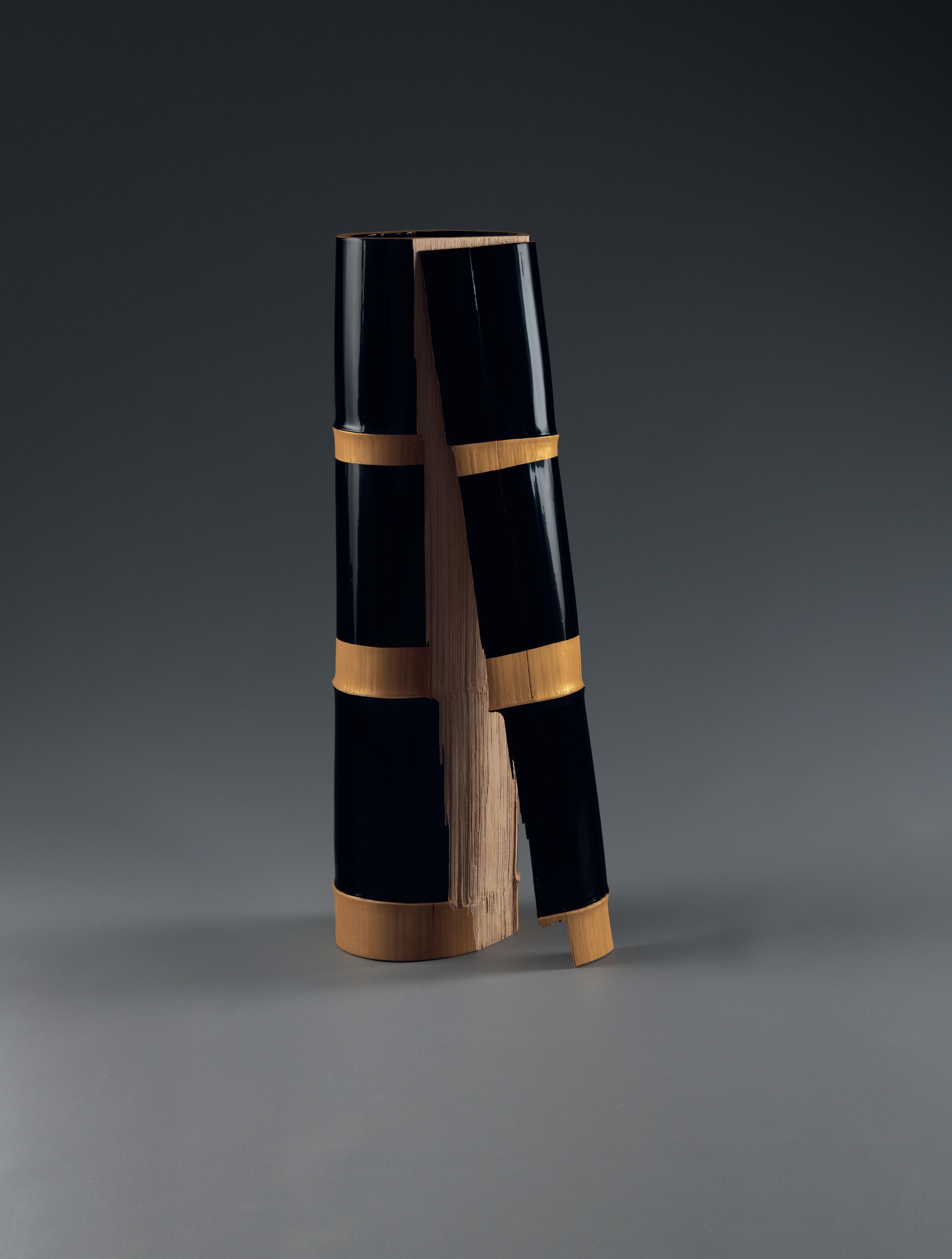
Height: 35.5cm
Installation width: 48.0cm



3
Height: 70.0cm
Width: 13.6cm
Depth: 7.7cm

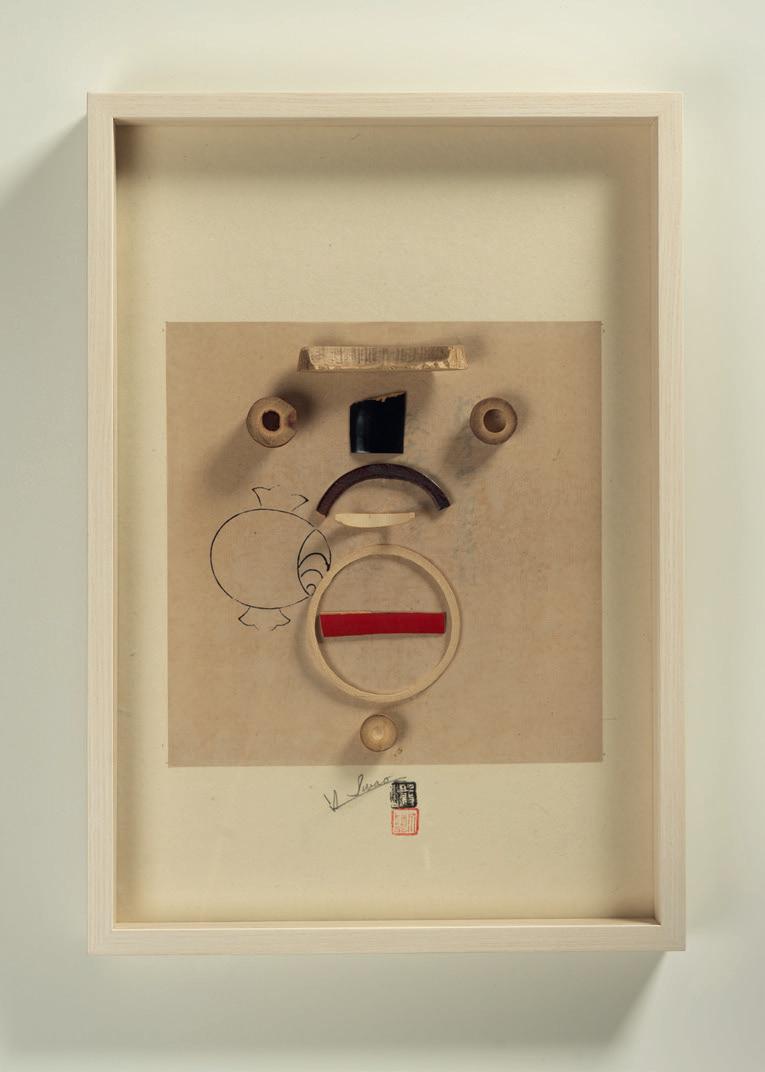
4
Shik ō no Danpen ( Fragment of Thought ), 2025
Bamboo, lacquer, gold and washi paper
Signed: Ikeda Iwao , with artist’s seals
Dimensions: 49.5cm x 34.5cm x 5.5cm


5
Hanaire 93-002 flower vase, 1993
Bamboo, lacquer and gold
Height: 35.5cm
Width: 10.0cm
Depth: 8.2cm
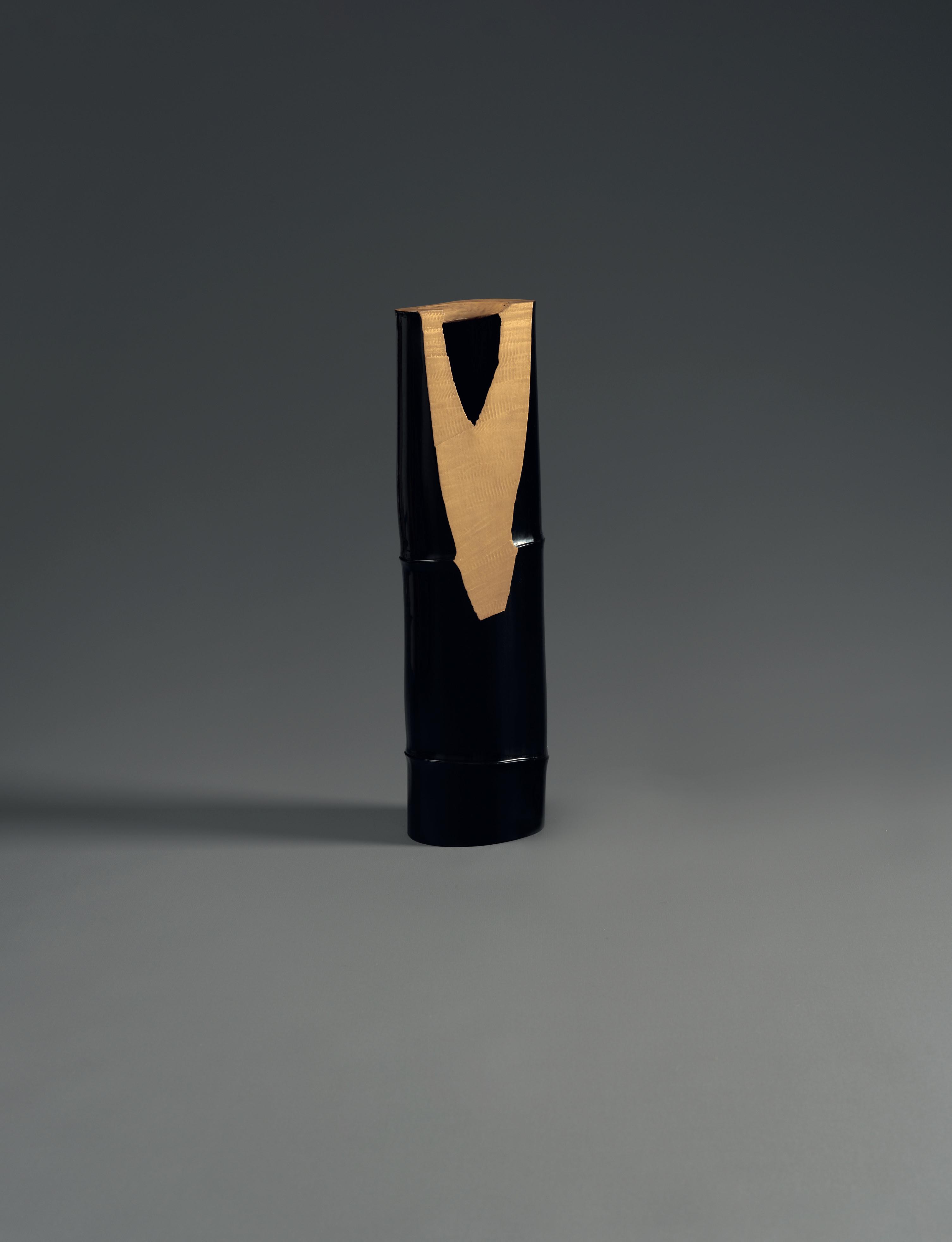
Sugiura Noriyoshi (b. 1964)
11. Tamentai no obuje (Polyhedron Objet), 2018
Signed: Noriyoshi
Madake bamboo, rattan and lacquer
Height: 26.0cm
Width: 41.0cm
Box inscription: Tamentai no obuje (Polyhedron Objet); Noriyoshi; Seal: Su -

6
Shik ō no Danpen ( Fragment of Thought ), 2025
Bamboo, lacquer, gold and washi paper
Signed: Ikeda Iwao , with artist’s seal
Dimensions: 49.3cm x 67.0cm x 6.6cm

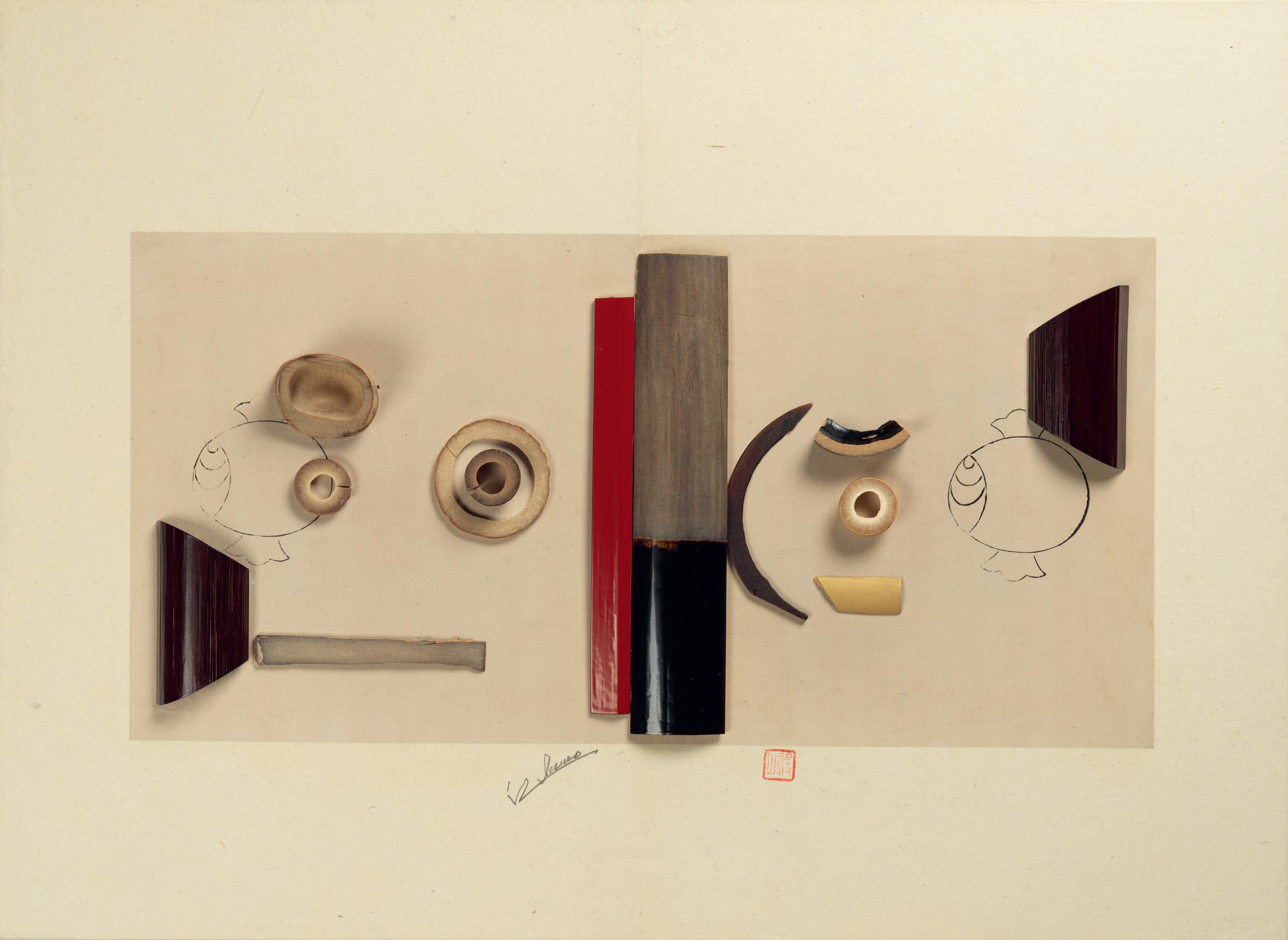

7
Shik ō no Danpen ( Fragment of Thought ), 2025
Bamboo, lacquer, gold and washi paper
Signed: Ikeda Iwao , with artist’s seals
Dimensions: 49.5cm x 34.5cm x 6.6cm

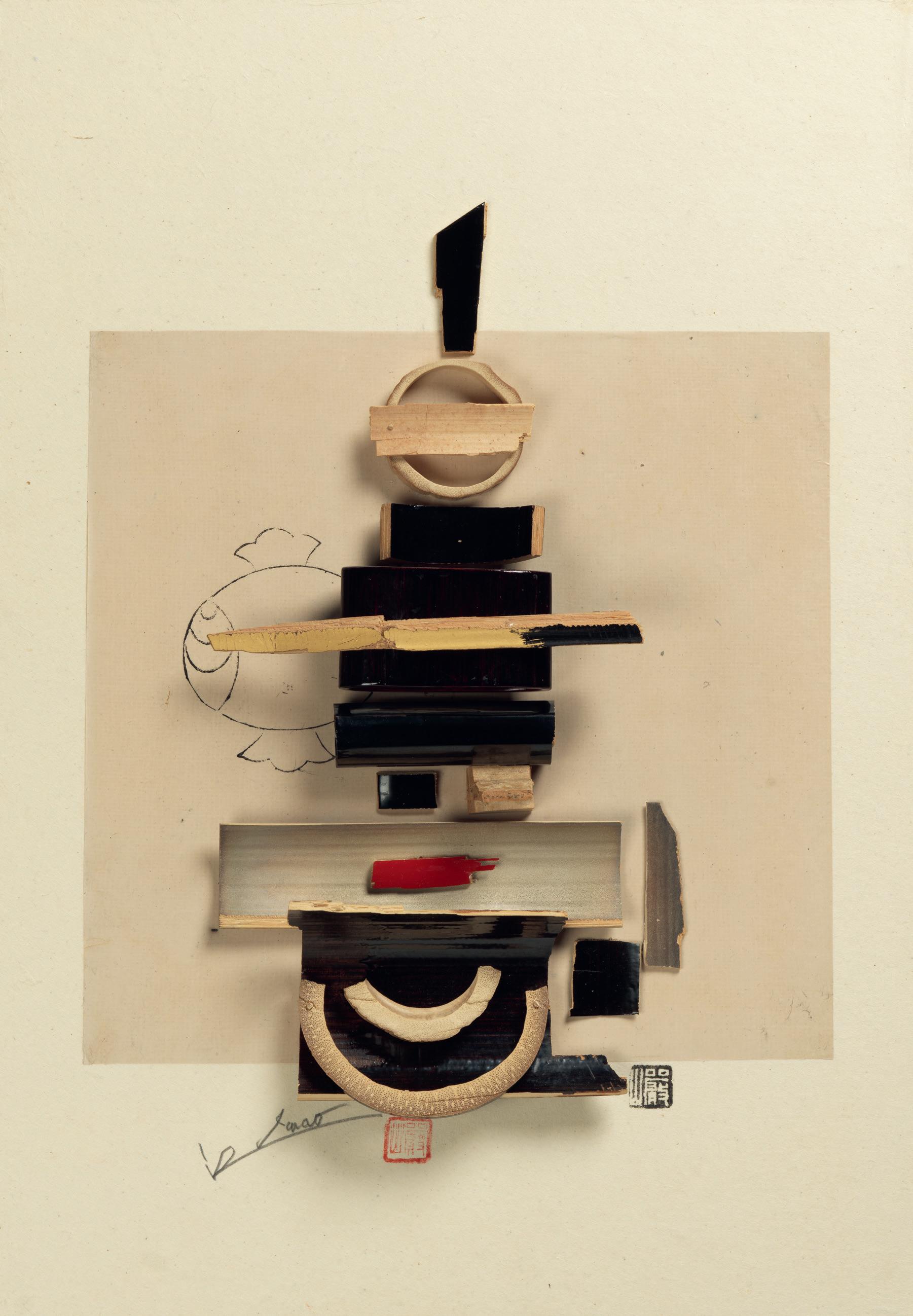
Height: 56.0cm
Width: 85.0cm
Depth: 85.0cm



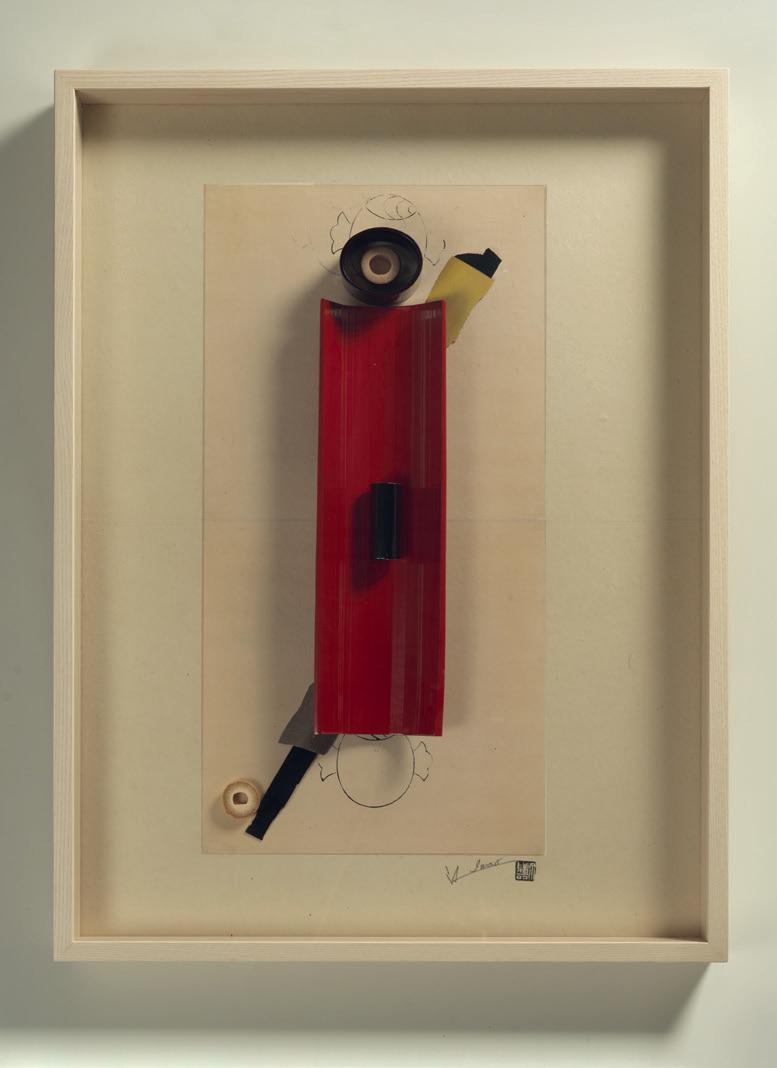
9
Shik ō no Danpen ( Fragment of Thought ), 2025
Bamboo, lacquer, gold and washi paper
Signed: Ikeda Iwao , with artist’s seal
Dimensions: 67.0cm x 49.5cm x 6.6cm


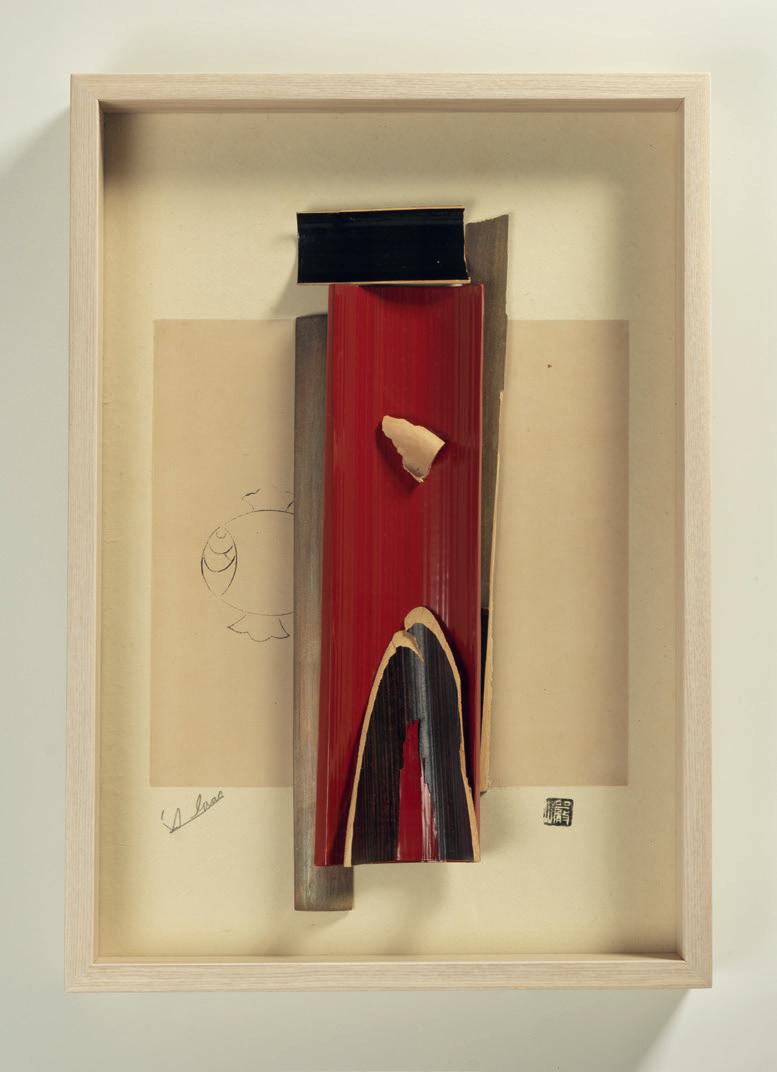
10
Shik ō no Danpen ( Fragment of Thought ), 2025
Bamboo, lacquer, gold and washi paper
Signed: Ikeda Iwao , with artist’s seal
Dimensions: 49.3cm x 34.5cm x 6.6cm

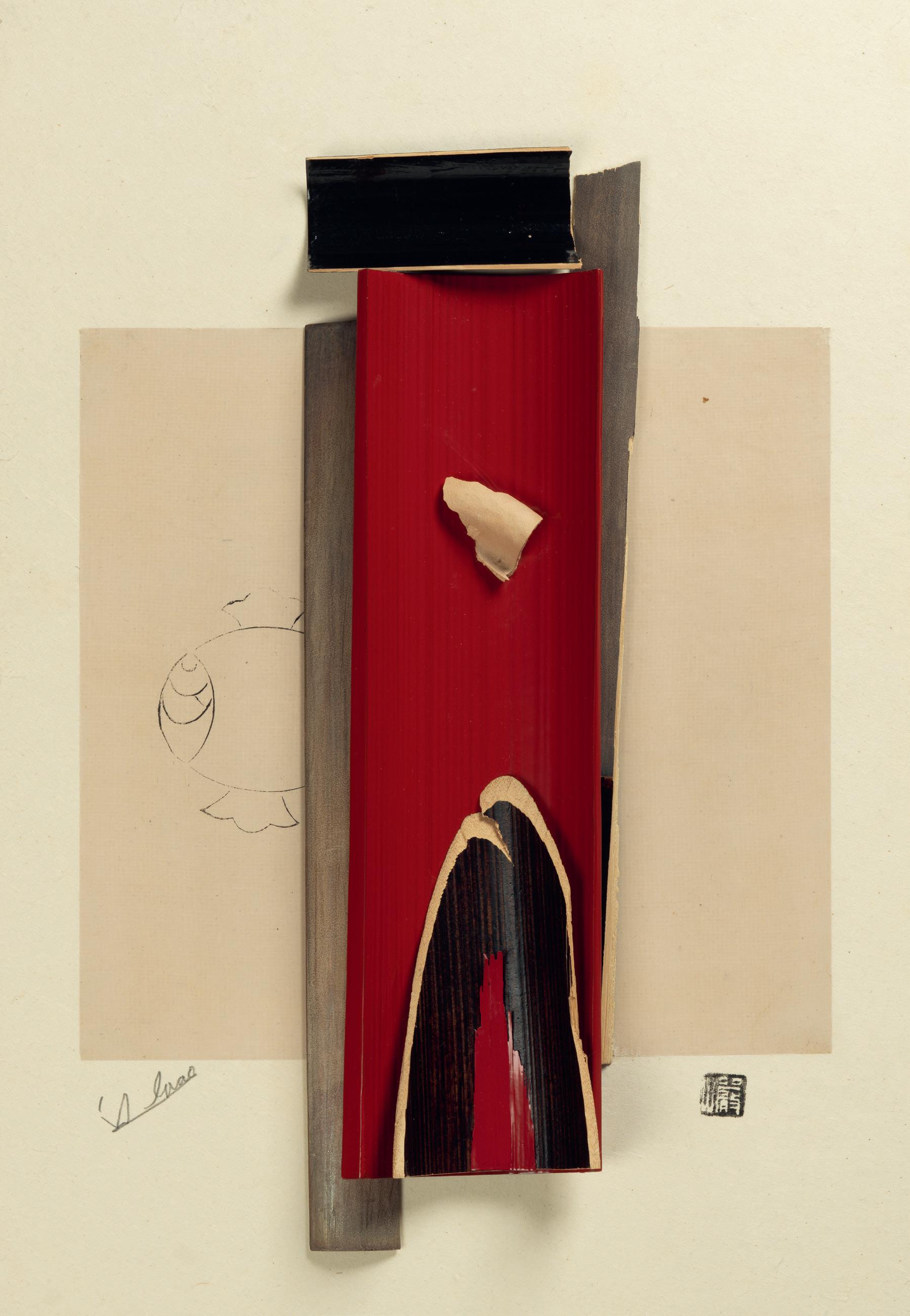
Ishiki no Kairi 3 ( Estrangement of Awareness 3 ), 2018
Bamboo, lacquer and gold
Height: 44.0cm


12
Shik ō no Danpen ( Fragment of Thought ), 2025
Bamboo, lacquer, gold and washi paper
Signed: Ikeda Iwao , with artist’s seal
Dimensions: 67.0cm x 49.0cm x 6.6cm



Shik ō no Danpen ( Fragment of Thought ), 2025
Bamboo, lacquer, gold and washi paper
Signed: Ikeda Iwao , with artist’s seal
Dimensions: 67.0cm x 49.0cm x 6.6cm

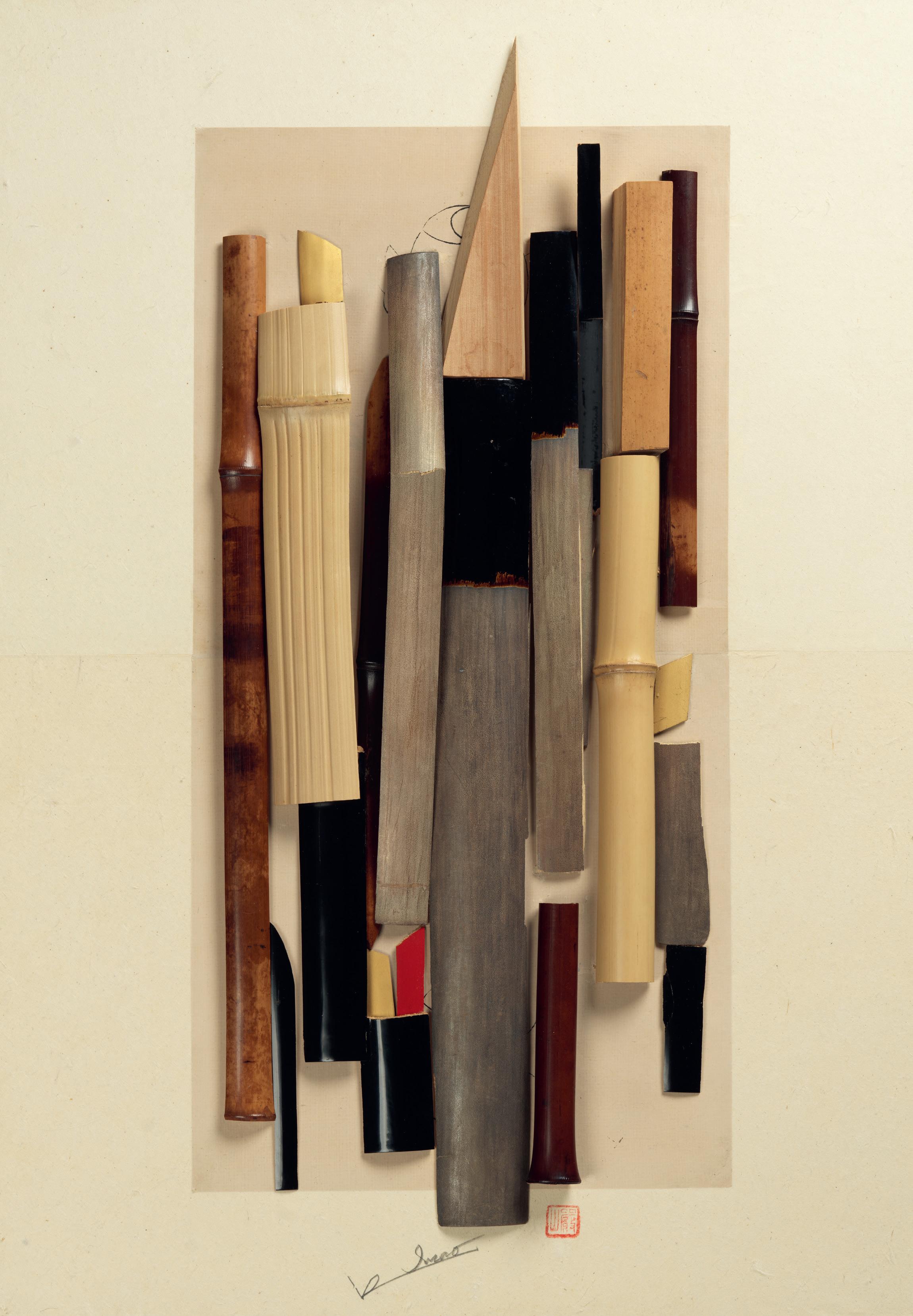
Height: 76.0cm
Width: 11.0cm
Depth: 6.0cm

Height: 105.0cm
Width: 15.0cm
Depth: 7.3cm




Height: 131.0cm
Width: 16.0cm
Depth: 12.5cm
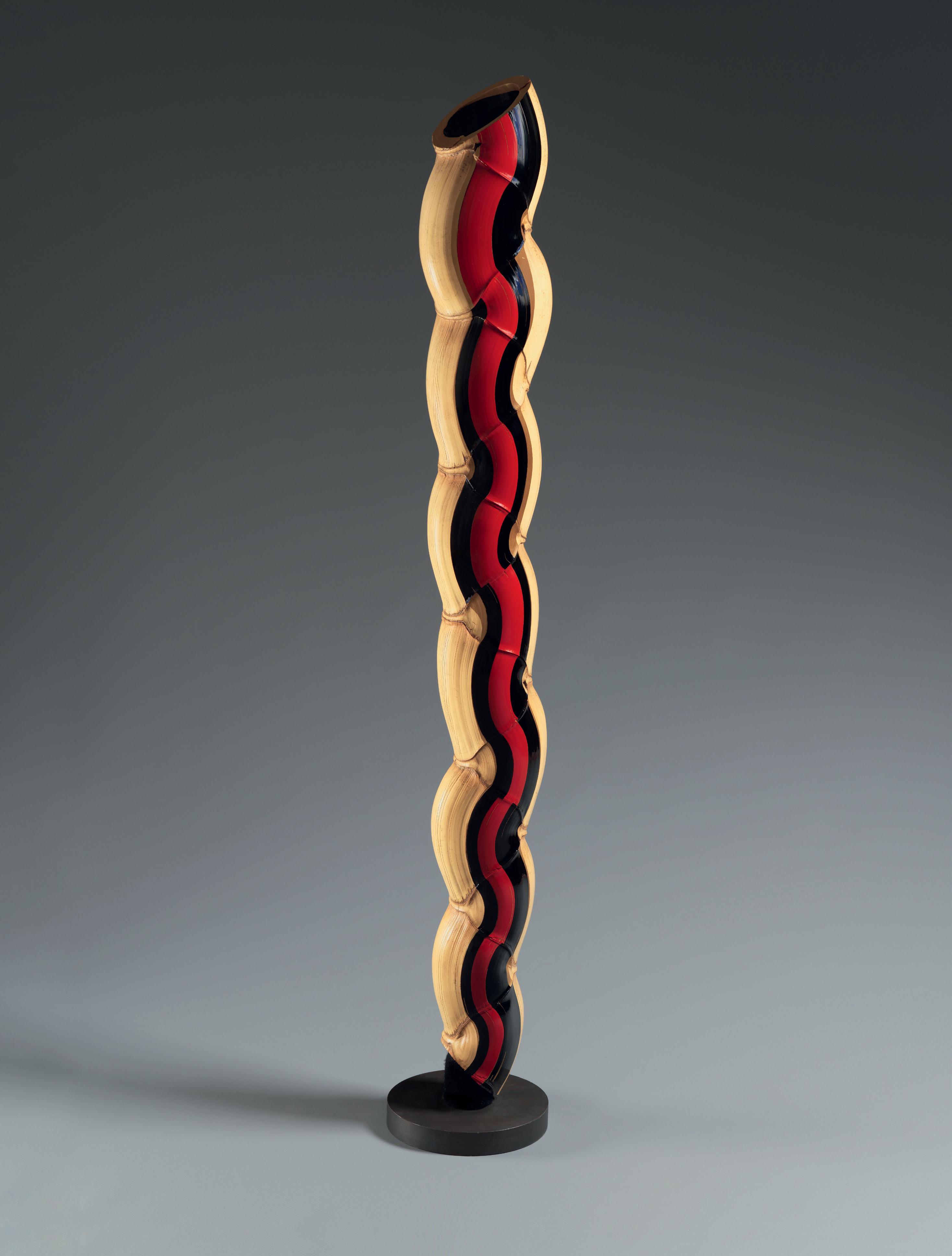
Works of art purchased from Eskenazi Ltd.
London, are now in the following museum collections:
Ackland Art Museum, North Carolina
Arita Porcelain Park Museum, Saga
Art Gallery of New South Wales, Sydney
Art Gallery of South Australia, Adelaide
Art Institute of Chicago, Chicago
Arthur M. Sackler Gallery, Washington, DC
Ashmolean Museum, Oxford
Asia House, Mr and Mrs John D Rockefeller 3rd Collection, New York
Asian Art Museum of San Francisco, San Francisco
Asian Civilisations Museum, Singapore
Baltimore Museum of Art, Baltimore
Birmingham Museum of Art, Alabama
British Museum, London
Brooklyn Museum, New York
Chang Foundation, Taibei
Chung Young Yang Embroidery Museum, Sookmyung Women’s University, Seoul, Korea
Cincinnati Art Museum, Cincinnati
Cleveland Museum of Art, Cleveland
Columbus Museum of Art, Columbus
Corning Museum of Glass, Corning
Dallas Museum of Art, Dallas
Dayton Art Institute, Dayton
Denver Art Museum, Denver
Designmuseum Danmark, Copenhagen
Didrichsen Art Museum, Helsinki
Fitzwilliam Museum, Cambridge
Flagstaff House Museum of Teaware, Hong Kong
Freer Gallery of Art, Washington, DC
Hagi Uragami Museum, Hagi
Hakone Museum of Art, Hakone
Harvard Art Museums, Cambridge, Massachusetts
Hetjens Museum, Düsseldorf
Hong Kong Museum of Art, Hong Kong
Honolulu Museum of Art, Honolulu
Idemitsu Museum of Arts, Tokyo
Indianapolis Museum of Art, Indianapolis Israel Museum, Jerusalem
Istituto Italiano per il Medio ed Estremo Oriente, Rome
Kimbell Art Museum, Fort Worth
Kuboso Memorial Museum of Arts, Izumi, Osaka
Los Angeles County Museum of Art, Los Angeles
Louvre Abu Dhabi, Abu Dhabi
M Woods Museum, Beijing
Matsuoka Museum of Art, Tokyo
Metropolitan Museum of Art, New York
Miho Museum, Shigaraki
Minneapolis Institute of Art, Minneapolis
MOA Museum of Art, Atami
Musée Ariana, Geneva
Musée des arts asiatiques, Nice
Musée national des arts asiatiques Guimet, Paris
Musées royaux d’Art et d’Histoire, Brussels
Museum für Asiatische Kunst, Berlin Museum für Kunst und Gewerbe, Hamburg Museum für Lackkunst, Münster
Museum für Ostasiatische Kunst, Cologne Museum of Fine Arts, Boston Museum of Fine Arts, Houston Museum of Islamic Art, Doha Museum of Oriental Ceramics, Osaka
Museum Rietberg, Zurich
National Gallery of Australia, Canberra
National Gallery of Canada, Ottawa
National Gallery of Victoria, Melbourne
National Museum of Singapore, Singapore
Nelson-Atkins Museum of Art, Kansas City
Nezu Museum, Tokyo
Norton Simon Museum, Pasadena Östasiatiska Museet, Stockholm
Princeton University Art Museum, Princeton
Royal Ontario Museum, Toronto
St. Louis Art Museum, St. Louis
Seattle Art Museum, Seattle
Shanghai Museum, Shanghai
Speed Art Museum, Louisville
State Administration of Cultural Heritage, Beijing
Toguri Museum of Art, Tokyo
Tokyo Fuji Art Museum, Tokyo
Tokyo National Museum, Tokyo
Tsui Museum of Art, Hong Kong
Tsz Shan Monastery Buddhist Art Museum, Hong K ong
Victoria and Albert Museum, London
Virginia Museum of Fine Arts, Richmond
Worcester Art Museum, Worcester
Zhiguan Museum of Fine Art, Beijing
March 1972 Inaugural exhibition Early Chinese ceramics and works of art.
June 1972 Georges Rouault, an exhibition arranged by Richard Nathanson.
June 1973 Ancient Chinese bronze vessels, gilt bronzes and early ceramics.
November 1973 Chinese ceramics from the Cottle collection.
December 1973 Japanese netsuke formerly in the collection of Dr Robert L Greene.
June 1974 Early Chinese ceramics and works of art.
November 1974 Japanese inro - from the collection of E A Wrangham.
May 1975 Japanese netsuke and inro - from private collections.
June 1975 Ancient Chinese bronzes from the Stoclet and Wessén collections.
June 1976 Chinese jades from a private collection.
June 1976 Michael Birch netsuke and sculpture.
June 1976 Japanese netsuke and inro - from private collections.
June 1977 Ancient Chinese bronze vessels, gilt bronzes and sculptures; two private collections, one formerly part of the Minkenhof collection.
June 1978 Ancient Chinese sculpture.
June 1978 Michael Webb netsuke.
June 1978 Eighteenth to twentieth century netsuke.
June 1979 Japanese netsuke from private collections.
June 1980 Jap anese netsuke from private collections and Michael Webb net suke.
July 1980 Ancient Chinese bronzes and gilt bronzes from the Wessén and other collections.
December 1980 Chinese works of art from the collection of J M A J Da wson.
October 1981 Japanese netsuke and inro - from the collection of Professor and Mrs John Hull Grundy and other private collections.
December 1981 Ancient Chinese sculpture.
October 1982 Japanese inro - from private collections.
November 1983 Michael Webb, an English carver of netsuke.
October 1984 Japanese netsuke, ojime, inro - and lacquer-ware.
June 1985 A ncient Chinese bronze vessels, gilt bronzes, inlaid bronzes, silver, jades, ceramics – Twenty five years.
December 1986 Japanese netsuke, ojime, inro - and lacquer-ware.
June 1987 Tang.
June 1989 Chinese and Korean art from the collections of Dr Franco Vannotti, Hans Popper and others.
November 1989 Japanese lacquer-ware from the Verbrugge collection.
December 1989 Chinese art from the Reach family collection.
May 1990 Japanese netsuke from the Lazarnick collection.
June 1990 Ancient Chinese sculpture from the Alsdorf collection and others.
November 1990 The Charles A Greenfield collection of Japanese lacquer.
June 1991 Inlaid bronze and related material from pre-Tang China.
November 1992 Japanese lacquer-ware – recent acquisitions.
December 1992 Chinese lacquer from the Jean-Pierre Dubosc collection and others.
June 1993 Early Chinese art from tombs and temples.
June 1993 Japanese netsuke from the Carré collection.
June 1994 Yuan and early Ming blue and white porcelain.
June 1995 Early Chinese art: 8th century BC – 9th century AD.
October 1995 Adornment for Eternity, loan exhibition from the Denver Art Museum.
June 1996 Sculpture and ornament in early Chinese art.
November 1996 Japanese inro - and lacquer-ware from a private Swedish collection.
March 1997 Ceramic sculpture from Han and Tang China.
June 1997 Chinese Buddhist sculpture.
June 1997 Japanese netsuke, ojime and inro - from the Dawson collection.
November 1997 Japanese netsuke – recent acquisitions.
March 1998 Animals and animal designs in Chinese art.
June 1998 Japanese netsuke, ojime and inro - from a private European collection.
November 1998 Chinese works of art and furniture.
March 1999 Ancient Chinese bronzes and ceramics.
November 1999 Ancient Chinese bronzes from an English private collection.
March 2000 Masterpieces from ancient China.
November 2000 Chinese furniture of the 17th and 18th centuries.
March 2001 Tang ceramic sculpture.
November 2001 Chinese ceramic vessels 500 – 1000 AD.
March 2002 Chinese Buddhist sculpture from Northern Wei to Ming.
November 2002 Two rare Chinese porcelain fish jars of the 14th and 16th centuries.
March 2003 Chinese works of art from the Stoclet collection.
November 2003 Song: Chinese ceramics, 10th to 13th century.
March 2004 Chinese Buddhist figures.
November 2004 A selection of Ming and Qing porcelain.
March 2005 Ancient Chinese bronzes and sculpture.
November 2005 Song ceramics from the Hans Popper collection.
March 2006 A selection of early Chinese bronzes.
June 2006 Recent paintings by Arnold Chang.
November 2006 Chinese porcelain from the 15th to the 18th century.
March 2007 Song: Chinese ceramics, 10th to 13th century (part 3).
November 2007 Mountain landscapes by Li Huayi.
March 2008 Chinese sculpture and works of art.
October 2008 Chinese ceramics and stone sculpture.
October 2009 Seven classical Chinese paintings.
March 2010 Trees, rocks, mist and mountains by Li Huayi.
November 2010 Fiftieth anniversary exhibition: twelve Chinese masterworks.
March 2011 Early Chinese metalwork in gold and silver; works of art of the Ming and Qing dynasties.
November 2011 Chinese huanghuali furniture from a private collection.
November 2011 The twelve animals of the zodiac by Li Huayi.
November 2012 Qing porcelain from a private collection.
October 2013 Junyao.
October 2013 Bo Ju Gui: an important Chinese archaic bronze.
October 2014 Waterfalls, rocks and bamboo by Li Huayi.
October 2014 Chinese sculpture c. 500 - 1500.
May 2015 Principal wares of the Song period from a private collection.
October 2015 Transfigured echoes: recent paintings by Liu Dan.
October 2016 Recent paintings by Zeng Xiaojun.
November 2016 Early Chinese art from private collections.
November 2017 Six Dynasties art from the Norman A. Kurland collection, Part one.
May 2018 Song: Chinese ceramics, 10th to 13th century (part 5).
May 2018 Gogottes: a rift in time.
November 2018 Six Dynasties art from the Norman A. Kurland collection, Part two.
November 2019 Room for study: fifty scholars’ objects.
October 2021 Tang: ceramics, metalwork and sculpture.
June 2022 Contemporary bamboo: masters from Japan.
June 2022 Gogottes: unfolding time.
October 2022 50 years of exhibitions: five masterpieces on loan from a private family collection
June 2023 Between perfection and destruction: Fang Lijun porcelain sculpture.
June 2023 Bamboo masterworks from Japan - classical to contemporary.
October 2023 Chinese ceramics, lacquer and gold from the 12th to the 14th century
June 2024 Elegant playthings in wood, lacquer and stone.
November 2024 Blue and white porcelain from the Yuan and early Ming dynasties.
10 Clifford Street
London W1S 2LJ
Telephone: 020 7493 5464
e-mail: gallery@eskenazi.co.uk
web: www.eskenazi.co.uk
